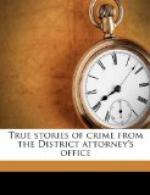The date of the forged will, June 30, 1900, was selected to correspond with the date of three genuine papers which Rice acknowledged before Short on that date.
[Illustration: Last page of the forged will of 1900, showing the forgery of Rice’s signature, and the false attestation of Short and Meyers.]
The next step was to obviate the absurdity of Patrick’s being selected as the residuary legatee at a time when he was engaged in bitter litigation against Rice. The best way out was for Patrick to pose as a lawyer who had brought about a settlement of this expensive litigation and thus won Rice’s regard. Patrick first tried to accomplish this by getting friends to visit Rice and urge a settlement. But Rice rebuffed them all. Accordingly, Patrick again resorted to forgery, and in August, 1900, manufactured an instrument of settlement, dated March 6, 1900.
But such an agreement would not explain the paradox of a man whom Rice hated and despised and did not know by sight turning up as the principal beneficiary under his will. It was necessary to manufacture evidence to be used after Rice’s death in support of his claim of close relations. The idea of a personal meeting with Rice had been abandoned on Jones’s advice, and Patrick therefore caused the valet to prepare twenty-five or thirty forged letters addressed to him and purporting to come from Rice. These referred to current business matters and conveyed the impression that it was Rice’s custom to seek the lawyer’s advice. One instructed Patrick as to the terms of the will of 1900. Carbon copies were made for filing in Rice’s letter book after his death.
To make assurance doubly sure and to secure immediate possession of Rice’s securities a general assignment to Patrick of all Rice’s estate was forged, and an order giving him access to and possession of the securities on deposit in Rice’s safety vault.
But Patrick did not stop here. He procured from Jones three checks signed by Mr. Rice in the regular course of business, one payable to Jones for his July salary and the other two for the July and August salary of an employee of Rice’s in Texas named Cohn. These three checks Patrick kept as models, forwarding to Cohn two forged checks filled out by Jones upon which Rice’s signature had been traced, and returning to Jones a substitute check with Rice’s signature traced upon it. All three checks passed through the banks unsuspected. Traced signatures were also substituted for genuine ones upon letters dictated by Rice to his Texas correspondents. Thus Patrick secured the circulation of five copies of Rice’s signature which, if occasion demanded, he could produce as standards of comparison to correspond with his other forgeries. The principal preparations were complete. But title under the will might long be delayed and perhaps even eventually fail. Patrick was poor and in no condition to conduct adequately a serious litigation. The moment Mr. Rice died




